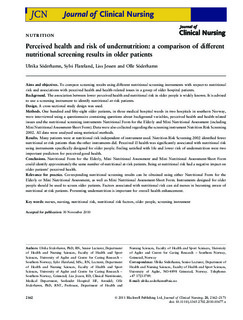| dc.contributor.author | Söderhamn, Ulrika | |
| dc.contributor.author | Flateland, Sylvi | |
| dc.contributor.author | Jessen, Liss | |
| dc.contributor.author | Söderhamn, Olle | |
| dc.date.accessioned | 2017-06-07T12:38:54Z | |
| dc.date.available | 2017-06-07T12:38:54Z | |
| dc.date.issued | 2011 | |
| dc.identifier.citation | Söderhamn, U., Flateland, S., Jessen, L. & Söderhamn, O. (2011) Perceived health and risk of undernutrition: a comparison of different nutritional screening results in older patients. Journal of Clinical Nursing, 20(15-16), s. 2162–2171. | |
| dc.identifier.uri | http://hdl.handle.net/11250/2445036 | |
| dc.description | Artikkelen rapporterer en studie hvor hensikten var å sammenligne screeningsresultater ved bruk av ulike ernæringsscreeninginstrumenter hos eldre pasienter i institusjon. | |
| dc.description.abstract | To compare screening results using different nutritional screening instruments with respect to nutritional risk and associations with perceived health and health-related issues in a group of older hospital patients. The association between lower perceived health and nutritional risk in older people is widely known. It is advised to use a screening instrument to identify nutritional at-risk patients. A cross-sectional study design was used. One hundred and fifty-eight older patients, in three medical hospital wards in two hospitals in southern Norway, were interviewed using a questionnaire containing questions about background variables, perceived health and health-related issues and the nutritional screening instruments Nutritional Form for the Elderly and Mini Nutritional Assessment (including Mini Nutritional Assessment-Short Form). Data were also collected regarding the screening instrument Nutrition Risk Screening 2002. All data were analysed using statistical methods. Many patients were at nutritional risk independent of instrument used. Nutrition Risk Screening 2002 identified fewer nutritional at-risk patients than the other instruments did. Perceived ill health was significantly associated with nutritional risk using instruments specifically designed for older people. Feeling satisfied with life and lower risk of undernutrition were two important predictors for perceived good health. Nutritional Form for the Elderly, Mini Nutritional Assessment and Mini Nutritional Assessment-Short Form could identify approximately the same number of nutritional at-risk patients. Being at nutritional risk had a negative impact on older patients' perceived health. Corresponding nutritional screening results can be obtained using either Nutritional Form for the Elderly or Mini Nutritional Assessment, as well as Mini Nutritional Assessment-Short Form. Instruments designed for older people should be used to screen older patients. Factors associated with nutritional risk can aid nurses in becoming aware of nutritional at-risk patients. Preventing undernutrition is important for overall health enhancement. | |
| dc.language.iso | eng | |
| dc.subject | pasientsikkerhet | |
| dc.subject | ernæring | |
| dc.subject | underernæring | |
| dc.subject | sykepleie | |
| dc.subject | sykepleier | |
| dc.subject | ernæringsrisiko | |
| dc.subject | risikofaktorer | |
| dc.subject | eldre | |
| dc.subject | institusjon | |
| dc.subject | sykehus | |
| dc.subject | screening | |
| dc.subject | Mini Nutritional Assessment | |
| dc.subject | MNA | |
| dc.subject | Nutritional Form For the Elderly | |
| dc.subject | NUFFE | |
| dc.subject | sykehus | |
| dc.subject | Norge | |
| dc.title | Perceived health and risk of undernutrition: a comparison of different nutritional screening results in older patients | |
| dc.type | Journal article | |
| dc.rights.holder | Söderhamn, Ulrika | |
| dc.source.volume | 20 | |
| dc.source.journal | Journal of Clinical Nursing | |
| dc.source.issue | 15-16 | |
| dc.identifier.doi | 10.1111/j.1365-2702.2010.03677.x | |
